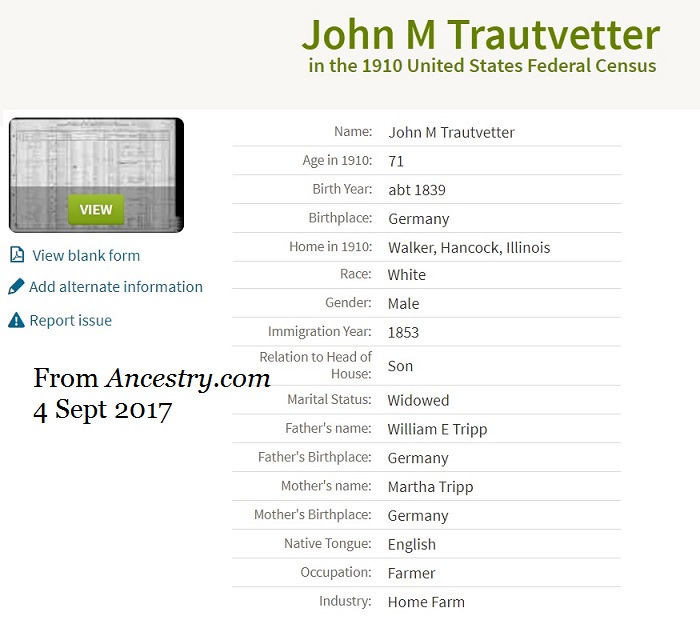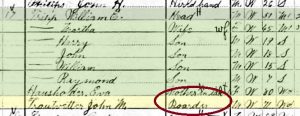
The transcription indicates that John was the “son” of the head of household.
I knew the transcription was wrong. My seventy-one year old ancestor was not living with his parents in 1910. He was not necessarily too old to have any living parents, but by 1910 his parents were actually deceased.
Viewing the actual census indicated that John was a boarder in the household of William Tripp in Hancock County, Illinois’ Walker Township. John had lived in the township since his 1868 marriage, still owned a farm in 1910 (which he would own at his death), and had several children and extended family members living nearby.
It is not known why he is living with the Tripps in 1910. They are not members of John’s extended family who also lived in the area. They are certainly not his parents.
John’s occupation is listed as a farmer on a “home farm” and he indicated that his farm is owned free. Based upon local mortgage records and probate records for John after his death, the farm was not free and clear in 1910. However, based upon those records, the value of the farm was approximately three times the initial value of the mortgage and was worth even more when sold after his death. Probate records indicate that the income from John’s farm was more than adequate to cover the regular payments on the mortgage and there was never any danger of default. Why the census record indicated the farm was owned free and clear is not known.
It is possible that John did not provide the information for his enumeration and whoever did simply assumed his farm was owned free and clear. Interestingly enough, John’s year of immigration to the United States (1853–note this originally was posted as “1953”) as listed in the census is correct.
William Tripp was renting farmland in Walker Township in 1910 according to the census enumeration so knowing exactly where he lived within the township is difficult. There is no indication of whether or not the farm he rented was Trautvetter’s farm. However, Tripp and Trautvetter are both indicated as reporting information on separate farm schedules. Those schedules have been destroyed so it is impossible to know exactly what they said for either Tripp or for Trautvetter.
Apparently the transcriber tripped over this enumeration when transcribing Trautvetter’s line in the entry. That’s why researchers should not let Ancestry.com automatically pull relationships from their transcriptions into their databases. Check, check, and check.
Otherwise you might trip over a relationship.
Barbara says:
Sorry to point out a typo If the census us 1910 I dont think he came 1953 as you typed. We all type those errors. The census shows 1853 🙂
mjnrootdig says:
Thanks! I’ll fix it.
Gayle M Glick says:
Yes, transcribers sometimes put what they think they see rather than what they actually see.
Pamela Cates says:
ALWAYS look at rhe original if possible. Transcriptionists frequently make mistakes and info that is important is not added. Also look at ajoining famulies etc , you frequently find relatives or in laws, more info
Kat says:
I wonder if the Ancestry transcribers can read or think! I’ve seen too many examples of wrong information.
Tammy says:
Transcribing these old records is very difficult. Mistakes are made, yes, but think how much information we would have if people weren’t willing to take on this very difficult task. On another site, not Ancestry, my aunt was indexed as being born in Kansas City, Montana. I’m grateful for the work these people, mostly volunteers, do. Maybe some day we will have the ability to offer corrections, but until then, I will be very grateful for what we have.
Cindi says:
Of course Ancestry transcribers can read and think! Transcription is not an easy task, faded images, mispellings, bad (and very bad) handwriting…. It’s easy to look at an image when we know what the name should be and see the transcription error. I’ve found lots of missing ancestors that way. But look at all the other information that you might miss if you didn’t look at the original image. How many years they’ve been married. Is this the 1st or 2nd marriage, how many living children, can they read or write. It just helps to pull the story of your ancestors together.
Patty says:
How interesting because I just recently ran across something in a similiar manner. Acquired by new family history. The two families were really good friends and both owned areas of land together. I know I have to dig deep to see if or how true this is. I really understand ur information you put out more & more all the time. Thank u so very much 4 all u do to help us out.
Carla says:
There have been MANY mistakes [or incidences of pure lazyness] by Ancestry transcribers. The best one was WWI Draft Cards that listed a fellow as having grey hair grey eyes and grey skin. Maybe the first two are possible, but the last one was a giveaway to the transcribers lazyness!